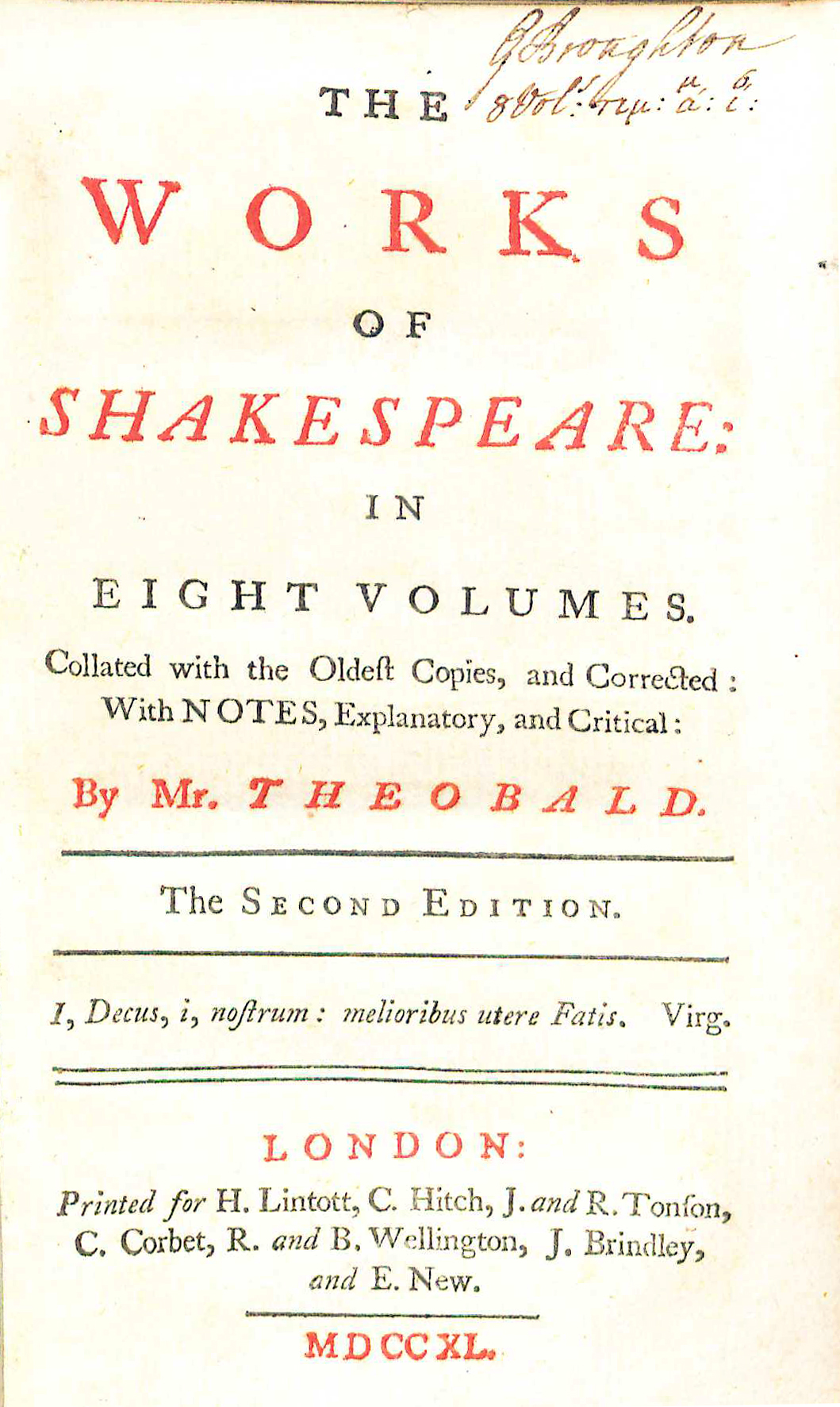Difference between revisions of "Works of Shakespeare"
| Line 4: | Line 4: | ||
__NOTOC__ | __NOTOC__ | ||
{{BookPageInfoBox | {{BookPageInfoBox | ||
| − | |imagename= | + | |imagename=ShakespeareWorks1740v1TitlePage.jpg |
|link=https://catalog.swem.wm.edu/law/Record/3466234 | |link=https://catalog.swem.wm.edu/law/Record/3466234 | ||
|shorttitle=The Works of Shakespeare | |shorttitle=The Works of Shakespeare | ||
Revision as of 10:42, 24 February 2014
The Works of Shakespeare: in Eight Volumes, Collated with the Oldest Copies, and Corrected
by William Shakespeare
| The Works of Shakespeare | |
|
Title page from The Works of Shakespeare, volume two, George Wythe Collection, Wolf Law Library, College of William & Mary. | |
| Author | William Shakespeare |
| Published | London: Printed for H. Lintott, C. Hitch, J. and R. Tonson, C. Corbet, R. and B. Wellington, J. Brindley, and E. New |
| Date | 1740 |
| Edition | Second |
| Language | English |
| Volumes | 8 volume set |
William Shakespeare (1564-1616) is a playwright and poet widely seen as the foremost writer in the English language.[1]
Shakespeare was an actor that begun to write plays sometime between 1585 and 1592. He began his career as a playwright with English histories, including Henry VI, comedies, including The Taming of the Shrew, and tragedies, including Titus Andronicus.[2] His first published work was the poem Venus and Adonis (1593).
His plays were beginning to be published in 1594, during which time he wrote Love’s Labour’s Lost, Richard II, Romeo and Juliet, and A Midsummer Night’s Dream. He continued to write prolifically during the late 1590s and 1600s. In 1606 Shakespeare wrote King Lear and Macbeth, which are both influenced by contemporary politics.
In 1609, Thomas Thorpe famously published Shakespeare’s sonnets, provoking controversy to this day about the rationale behind the order of the sonnets,[3] and the identity of “W.H.” Thorpe included in his epigraph.[4] By 1609, about half of Shakespeare’s plays had been printed. Shakespeare continued to write plays until 1613, and he died in 1616.
Shakespeare is known for his exploration of human nature, as Samuel Johnson states in his famous “Preface to the Works of Shakespeare”:
His persons act and speak by the influence of those general passions and principles by which all minds are agitated, and the whole system of life is continued in motion. . . . Shakespeare has no heroes; his scenes are occupied only by men, who act and speak as the reader things that he himself should have spoken and acted on the same occasion.[5]
The Works of Shakespeare: In Eight Volumes was published in 1740, during a time when Shakespeare was enormously popular in England. It includes multiple elegies written about Shakespeare, his will, and biographical documents that provide a background of Shakespeare’s life, in addition to his plays.
Evidence for Inclusion in Wythe's Library
Listed in the Jefferson Inventory of Wythe's Library as Shakespeare by Theobald. the first 6.v. 12mo. and given by Thomas Jefferson to his granddaughters, Ann and Ellen Randolph. The precise edition of the incomplete set owned by Wythe is unknown. George Wythe's Library[6] on LibraryThing indicates as much, adding "Duodecimo editions were published in seven volumes at Dublin in 1739; in eight volumes at London in 1740, 1752, 1757, 1762, 1767, and 1773; and in twelve volumes at London in 1772." The Brown Bibliography[7] lists the first edition, seven volume set published in London in 1733. The Wolf Law Library purchased a copy of the London second edition, eight volume set.
Description of the Wolf Law Library's copy
8 volumes bound in contemporary full calf with raised bands, red title labels and gilt decoration to spines. Frontis portrait of Shakespeare to volume one and a facing plate to each separate work throughout, after H. Gravetot, engraved by G. Vander Gucht. Purchased from Wadard Books.
View this book in William & Mary's online catalog.
References
- ↑ Peter Holland, “Shakespeare, William (1564–1616)”, Oxford Dictionary of National Biography (Oxford University Press, 2004), accessed October 7, 2013. Unless otherwise noted, all biographical details are from this source.
- ↑ S. Schoenbaum, “William Shakespeare, Gentleman,” The Wilson Quarterly (1976-), 3, No. 1 (Wilson Quarterly, Winter 1979), p. 184.
- ↑ J.A. Fort, “The Order and Chronology of Shakespeare’s Sonnets,” The Review of English Studies, 9, No. 33 (Oxford University Press, 1933), p. 22.
- ↑ Donald W. Foster, “Master W.H., R. I. P.,” PMLA, 102, No. 1 (Modern Language Association, Jan. 1979), p. 42.
- ↑ Samuel Johnson, “Preface,” The Plays of William Shakespeare, accessed through Shakespeare’s Editors (Palomar 2009), vii and xii.
- ↑ LibraryThing, s. v. "Member: George Wythe," accessed on November 18, 2013, http://www.librarything.com/profile/GeorgeWythe
- ↑ Bennie Brown, "The Library of George Wythe of Williamsburg and Richmond," (unpublished manuscript, May, 2012) Microsoft Word file. Earlier edition available at: https://digitalarchive.wm.edu/handle/10288/13433
